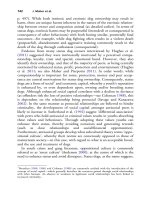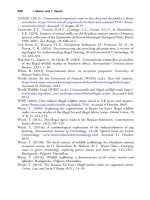The palgrave international handbook of a 282
Bạn đang xem bản rút gọn của tài liệu. Xem và tải ngay bản đầy đủ của tài liệu tại đây (37.86 KB, 1 trang )
Animal Racing: Shifting Codes of Canadian Social Tolerance
279
and less acceptable. The collective taste for viewing or participating in certain
violent acts, even indirectly as spectators, has been referred to by Elias (2000)
as a ‘threshold of repugnance’. For Elias, such a ‘threshold’ is not dormant or
stagnant but, rather, shifts dynamically over time in keeping with other social
changes.
For Elias (1986b), people in increasingly ‘civilized’ societies are expected
to control aggressive impulses toward other humans and other living things.
As such, as wider civilizing occurs at a macro-societal level, forms of entertainment previously found to be acceptable face increased scrutiny and
possible rejection. Elias cites examples from the past of public torture and
executions as acts viewed to be increasingly displeasureable, and Pinker
(2011) shows how public cruelty toward animals (such as the public burning
of cats to exorcise what was seen as the physical incarnation of evil) has
changed massively over time. Elias explains how in an overall trend toward
civilization societies are prone to both ‘spurts’ of civilization and de-civilization
(Elias and Dunning 1986; Dunning 1999; Elias 2000). In the latter case, an
event, process, practice or institution may hold out as a bastion of a form of
once accepted but now contested behaviour.
Changing views in Canadian society vis-à-vis the appropriate treatment of
animals and placing animals at risk for public entertainment and economic
profit fall in line with what Eliasian scholars would deem to be a ‘civilizing
spurt’. The debate over rodeo and chuckwagon racing may well fit with a
broader civilizing spurt, but the actual rodeo and chuckwagon events themselves are consistent with what Elias would term ‘modern barbarism’ (van
Krieken 1998, p. 112), what Elias and Dunning (1986, 1999) would deem
instances of de-civilization. Evidence of de-civilization related to modern
chuckwagon races at the Stampede can be found in progressions of the
sport itself. Van Herk explains how chuckwagon racing has become faster,
riskier and more entertaining for spectators; once heavily set horses have been
replaced by hyper-fit, lightweight thoroughbreds that now pull lighter
wagons at far greater speeds (2008, p. 243). The audience desire to witness
riskier behaviour and experience more excitement with increased risk to
driver and horse alike fits within the Eliasian definitions of de-civilizing
spurts.
The figurationalist notions of ‘civilizing’ and ‘de-civilizing’ are hardly
linear in their real world examples. The Calgary Stampede Rangeland
Derby is evidence of this. The (de-civilizing) increase of risk and injury in
order to build tension and excitement occurs within a broader (and civilizing) societal rejection of, or at least concern with, exposing animals to
unnecessary risk for mere entertainment. Even within what could be termed









